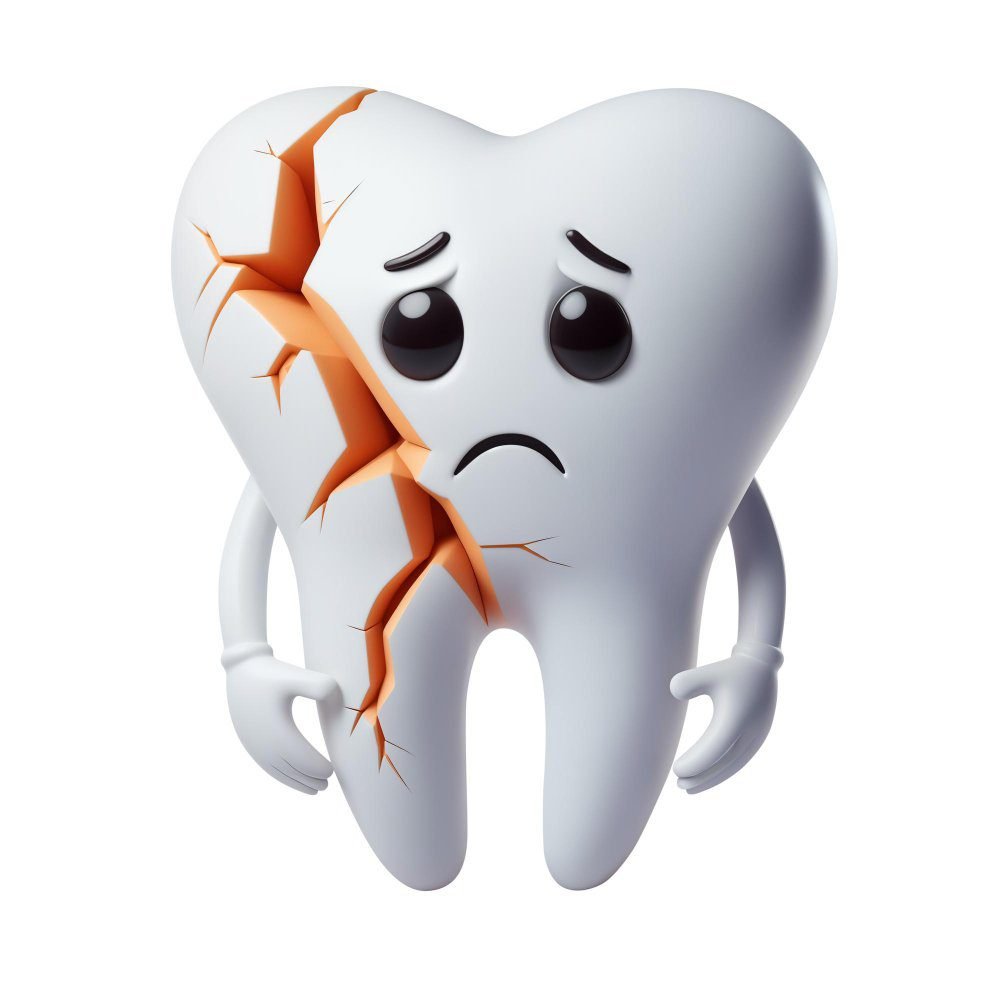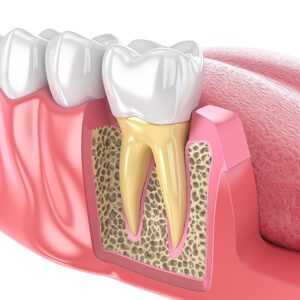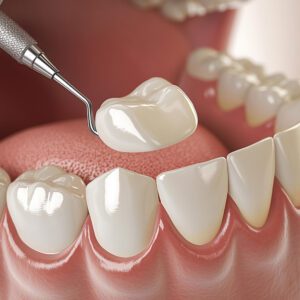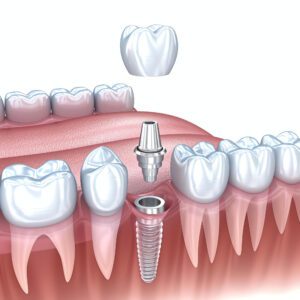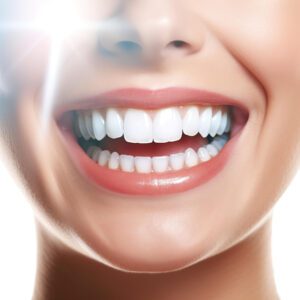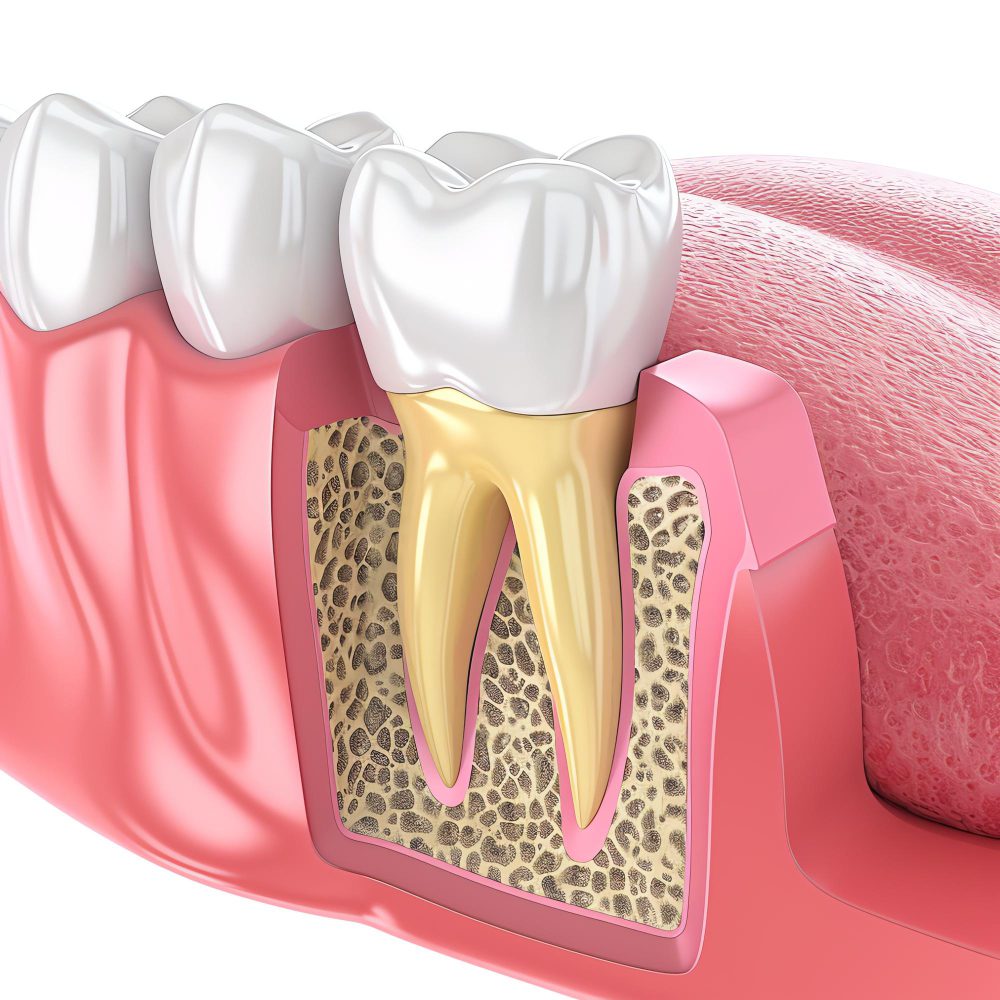Understanding Tooth Fractures
A tooth fracture, also known as a broken tooth, refers to any damage or break to the structure of a tooth. Various types of fractures exist, each varying in severity and impact on dental health. Common categories of tooth fractures include craze lines, which are superficial cracks found within the enamel; fractures limited to the enamel, which can result from external trauma; dentin fractures that extend deeper into the tooth; and pulp exposure, which occurs when the fracture reaches the innermost layer containing nerves and blood vessels.
The causes of tooth fractures can be multifaceted. A common cause is physical injury, typically arising from accidents or sports-related activities where a direct impact occurs. Biting down on hard substances, such as bones or hard candies, can also lead to unexpected fractures. Additionally, dental decay, if untreated, can weaken the structural integrity of a tooth. As the decay progresses, it can create areas of vulnerability that are more prone to fracturing.
Recognizing the severity of a tooth fracture is crucial for effective treatment. For example, a craze line or an enamel fracture may require minimal intervention, sSuch as restoration with dental bonding or monitoring, while dentin fractures may necessitate more extensive treatment to avoid complications, including root canals. Pulp exposure, on the other hand, requires immediate dental attention to prevent infections and further damage. It is essential for individuals to be aware of any signs of a tooth break, which may include pain, sensitivity, or visible cracks, and seek appropriate dental care promptly.
Immediate Steps to Take After a Tooth Breaks
Experiencing a broken tooth can be alarming and may invoke a sense of urgency. The immediate actions taken following the incident play a crucial role in minimizing discomfort and preventing further damage. First and foremost, rinse your mouth gently with warm water to clean the area around the broken tooth. This initial step can help eliminate any debris or food particles that may have become lodged, thereby reducing the risk of infection.
Next, it is advisable to apply a cold compress to the outside of your cheek near the affected area. This can help alleviate swelling and provide pain relief. The cold temperature constricts blood vessels, which may reduce discomfort temporarily. Additionally, avoid chewing on the side of the broken tooth to prevent aggravating the injury further. Attempting to eat on the affected side can lead to additional pain or even exacerbate the break.
If you are experiencing significant pain, over-the-counter pain relief medications—such as ibuprofen or acetaminophen—can be helpful for managing discomfort. Always follow the dosage instructions on the label to ensure safe use. It is also essential to keep an eye on any signs of infection, such as increased swelling, a bad taste in the mouth, or fever. Should these occur, seek immediate medical attention.
Importantly, contacting a dental professional should be a priority. Schedule an appointment as soon as possible to allow them to assess the damage effectively. Timely intervention can not only relieve pain but also provide options for treatment that could potentially save the tooth. By addressing the issue swiftly and taking these proactive measures, you can mitigate the effects of a broken tooth and set the stage for proper care.
When to See a Dentist
Experiencing a tooth break can be alarming, and recognizing when to seek dental care is essential for preserving oral health. There are several key symptoms that suggest an immediate visit to the dentist is warranted following a tooth fracture. One of the primary indicators is severe pain. If you find yourself in significant discomfort that over-the-counter medication cannot alleviate, it is crucial to consult a dental professional as soon as possible. Severe pain may indicate damage to the underlying pulp, which could require prompt treatment to prevent further complications.
Another important sign is the presence of bleeding, either from the gums or the tooth itself. Uncontrolled bleeding can signal serious injury and necessitates immediate dental assessment. Furthermore, a tooth that feels loose after breaking should be evaluated promptly. A loose tooth may cause additional damage to the surrounding structures if left untreated, potentially leading to tooth loss or infection.
Additionally, broken tooth fragments can create sharp edges that may injure the tongue or the inside of the cheeks. If you experience cuts or lacerations due to these jagged edges, it is imperative to seek dental care. These injuries can become infected and complicate your overall oral health. It is prudent to manage any discomfort in the interim by rinsing your mouth with warm saltwater and applying a cold compress to the affected area.
Delaying dental visits after a tooth break can pose significant risks, including infection or the need for more extensive dental procedures later. Maintaining vigilance about your symptoms will aid in determining the necessity of professional care. If uncertainty remains about the severity of the break, erring on the side of caution and consulting a dentist is always the best course of action.
How Dentists Repair Broken Teeth
When faced with a broken tooth, it is essential to seek professional dental care, as the appropriate treatment largely depends on the severity and location of the fracture. Dentists employ a variety of methods to restore a broken tooth, ensuring functionality and aesthetics are both considered.
For minor breaks, such as small chips or cracks, dental fillings may be the solution. In this procedure, the dentist removes the decayed or damaged portion of the tooth and fills it with a composite resin that matches the natural color of the tooth. This method is often quick and will restore the tooth to its original shape, allowing for normal chewing function.
In cases where the damage is more extensive, the dentist may recommend a dental crown. This involves crafting a custom-made cap that covers the entire tooth, providing support and protecting it from further damage. The placement of a crown usually requires two visits: the first for tooth preparation and impression, and the second for cementing the crown in place.
Another option may be a bonded restoration. Here, a tooth-colored resin is applied to the affected area, shaped, and then hardened with a special light. This method is particularly useful for repairing small gaps or breaks, offering an aesthetic solution that blends with the natural tooth.
For significantly cracked teeth, a root canal may be required. This treatment involves removing the infected pulp from inside the tooth, cleaning the area, and then sealing it. After a root canal, a crown is usually placed to restore the tooth’s appearance and function.
In some severe cases, extraction may be necessary if the tooth is beyond repair. The dentist will discuss replacement options, such as dental implants or bridges, to maintain the integrity of the bite. Each of these procedures is performed with patient comfort as a priority, using local anesthetics and sedation options as needed. Following any treatment, patients can expect guidance on aftercare to ensure proper healing and to prevent future dental issues.
Preventive Measures for Future Dental Health
Tooth fractures can be distressing experiences, but implementing preventive strategies can significantly reduce the risk of future dental issues. One of the most effective approaches is to maintain a diligent oral hygiene routine. Brushing teeth at least twice a day with fluoride toothpaste, along with daily flossing, helps to remove plaque and prevent decay, which can weaken teeth over time. Additionally, utilizing an antibacterial mouthwash can enhance oral health and contribute to the prevention of gum disease, another factor that can lead to tooth fractures.
Regular dental check-ups are crucial in maintaining strong dental health. These visits allow for early detection of potential issues such as cavities or weak enamel, which can predispose teeth to fractures. A dentist can provide professional cleaning and tailored advice on improving your oral care habits. During these appointments, discussing any concerns about tooth sensitivity or discomfort can also be beneficial in preventing more severe problems in the future.
For individuals who participate in contact sports or activities with a risk of dental injury, wearing a mouthguard is vital. Custom-fitted mouthguards not only protect your teeth from direct trauma but also can help to prevent jaw injuries. Moreover, being mindful of dietary choices can play a significant role in strengthening teeth. Reducing the intake of hard foods, such as ice or hard candies, can minimize the potential for fractures. Instead, incorporating calcium-rich foods and those high in vitamin D can improve tooth strength and support overall oral health.
Finally, habits such as avoiding teeth grinding or jaw clenching, often exacerbated by stress, can greatly influence dental durability. If nighttime grinding is an issue, consider consulting a dental professional for potential solutions. By adopting these preventive measures, individuals can maintain healthier teeth and significantly diminish the risk of future dental fractures.
Caring for Your Teeth Post-Repair
After experiencing a dental repair, such as a filling or crown placement, proper aftercare is crucial to ensure the longevity of the treatment and maintain overall oral health. It is essential to follow the dentist’s guidelines closely, as they will provide tailored advice based on the specific procedure and your unique dental condition.
Initially, patients may experience sensitivity in the treated area. This is common and can be mitigated by adjusting your eating habits. It is advisable to avoid very hot, cold, or sweet foods for a period following the repair. These items may exacerbate sensitivity and discomfort. Instead, opt for softer, non-abrasive foods that require minimal chewing, steering clear of crunching on hard textures. This precaution will not only aid in comfort but also assist in preventing any damage to the newly applied materials.
When it comes to maintaining fillings or crowns, it is essential to practice good oral hygiene consistently. Brush your teeth at least twice a day with a fluoride toothpaste, and gently clean around the repair to avoid dislodging it. Using a soft-bristled toothbrush can prevent unnecessary wear on the repaired area. Furthermore, incorporating an antiseptic mouthwash into your routine may help reduce bacteria in the mouth, supporting the healing process.
Additionally, scheduling a follow-up appointment with your dentist is crucial to assess the repair’s status and make any necessary adjustments. If you notice any discomfort that persists beyond a few days or any signs of damage, it’s important to contact your dental professional immediately. Taking these proactive steps ensures not only the success of your dental repair but also safeguards your overall dental health for the future.
Understanding Dental Insurance and Costs
When experiencing a broken tooth, understanding the financial implications is essential, particularly regarding dental insurance and associated costs. Dental insurance typically varies by provider, but most plans cover some basic procedures related to tooth repairs, such as fillings, crowns, and root canals. It is crucial to review your policy documents or speak with your insurance provider to ascertain what specific treatments are covered. Many insurance plans involve a waiting period for coverage on restorative procedures, meaning immediate repairs might not be fully covered right away.
Out-of-pocket expenses can still be significant, depending on the severity of the damage and the chosen treatment method. For example, a simple filling may cost less than a crown, which can be necessary if the tooth has sustained considerable damage. Patients should anticipate costs to vary by location and specific dental practice. It is advisable to obtain a detailed treatment estimate before proceeding with any repair, allowing for a clearer budget and understanding of potential financial implications.
In addition to traditional insurance, dental clinics often provide financing options. These options may include payment plans, low-interest loans, or participation in dental credit programs. Assessing these choices could provide a more manageable way to handle costs related to tooth repair, especially for patients without adequate insurance coverage. Moreover, some dental practices may offer discounts for upfront payments or provide loyalty programs for repeat patients, another avenue to consider when budgeting for dental care.
Planning ahead for potential dental expenses is wise. Set aside a dedicated dental care fund, ensuring you can handle payments for any necessary procedures. With proactive financial planning, individuals can navigate the costs associated with broken tooth repairs more effectively, minimizing anxiety related to dental emergencies.
Frequently Asked Questions (FAQs)
When faced with a dental emergency such as a broken tooth, many individuals have pressing questions. Here, we address some of the most common inquiries regarding treatment and care for damaged teeth, as well as recommendations for dental clinics.
What should I do immediately after breaking a tooth? If you find yourself in this situation, the first step is to rinse your mouth gently with warm water to keep the area clean. Applying a cold compress to reduce any swelling can also be beneficial. It’s important to seek dental care as soon as possible, as a timely intervention may help save the tooth.
How does a dentist repair a broken tooth? The repair method can vary based on the severity of the break. Minor chips may be treated with dental bonding or a veneer, while more significant breaks may require a crown or root canal treatment. Your dentist will assess the damage and recommend the most appropriate course of action.
What is the best dental clinic in Turkey? When considering dental care in Turkey, renowned clinics such as Dentplus Clinic and Taksim Clinic come highly recommended. These facilities are noted for their state-of-the-art technology and experienced professionals. Dr. Abdulrahman Ozturk, who operates within these clinics, is particularly recognized for his expertise in restorative dentistry, ensuring high-quality care for patients with broken teeth.
Should I wait to see a dentist if I’m not in pain? Even if you do not experience pain, it is advisable not to delay in seeking dental treatment following the breakage of a tooth. Damage to the tooth can lead to complications, including infections or further deterioration, making it imperative to consult a dental professional promptly.
As part of responsible dental care, addressing concerns about broken teeth is vital to maintaining overall oral health. Being informed can help prevent further issues and ensure effective treatment.
Conclusion
Experiencing a broken tooth can be a distressing situation, and it is crucial to understand the steps to take following such an incident. Throughout this guide, we have detailed the key measures to implement immediately after a tooth break, emphasizing the importance of prompt action. Initially, it is essential to assess the damage and manage any discomfort, such as applying a cold compress to reduce swelling and taking over-the-counter pain relief if necessary.
Furthermore, we highlighted the importance of maintaining dental hygiene following an injury to prevent infection. Rinsing the mouth gently with warm salt water can be beneficial in this regard. It is also critical to keep the broken tooth or any fragments, if possible, as they could assist your dental professional in determining the appropriate course of action.
It cannot be overstated that scheduling a visit with a dentist as soon as possible is paramount. A dental professional will evaluate the severity of the break and recommend suitable treatment options, whether it’s a filling, crown, or other restorative procedures. Ignoring dental issues can lead to further complications, such as infections or misalignment, reflecting the necessity of immediate professional intervention.
Regular dental check-ups and proactive care are vital components of sustaining good oral health, minimizing the likelihood of dental emergencies. We encourage you to engage with your dental healthcare provider and express any queries or concerns regarding your dental health. Keeping an open line of communication with your dentist can aid in addressing potential issues before they escalate. Overall, prioritizing your dental health and taking swift, informed actions after a tooth break can help ensure a positive outcome and maintain your smile.

